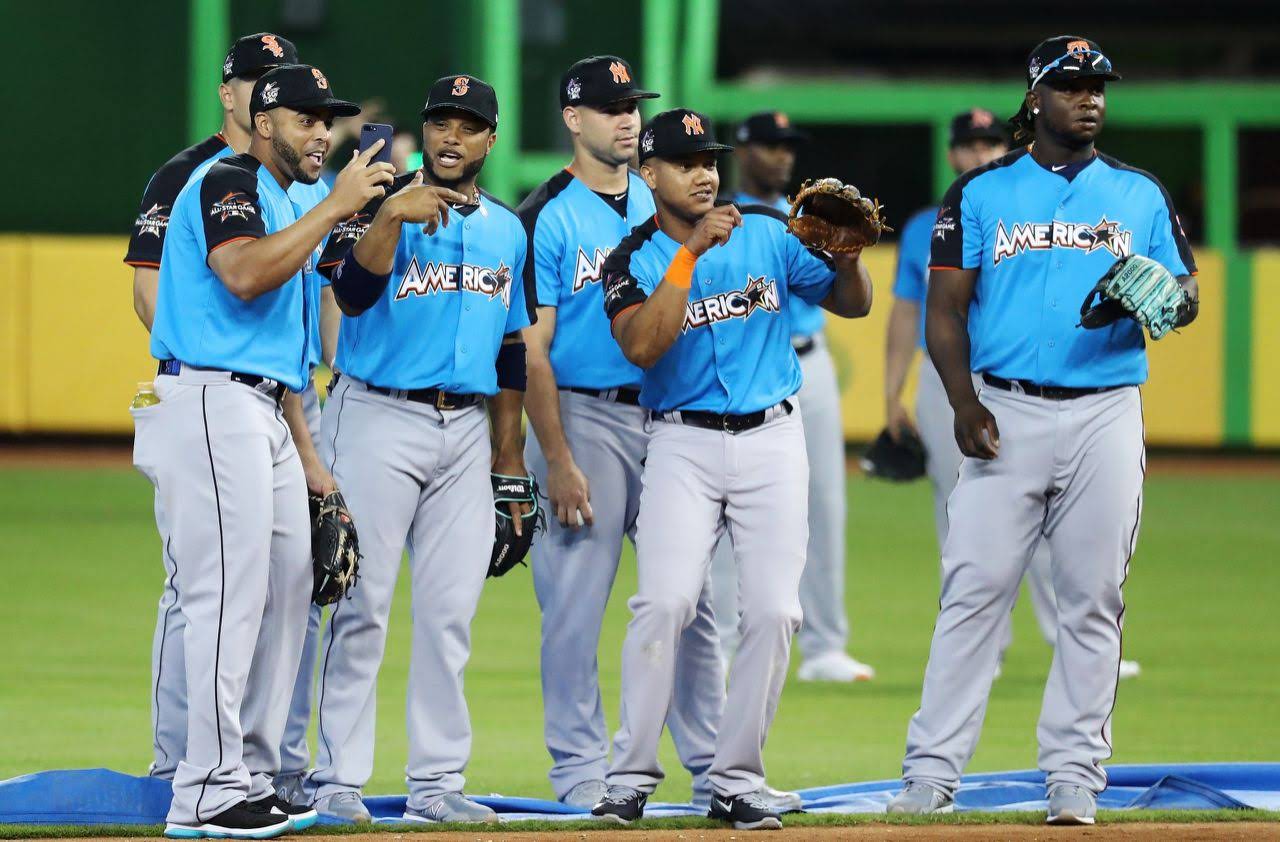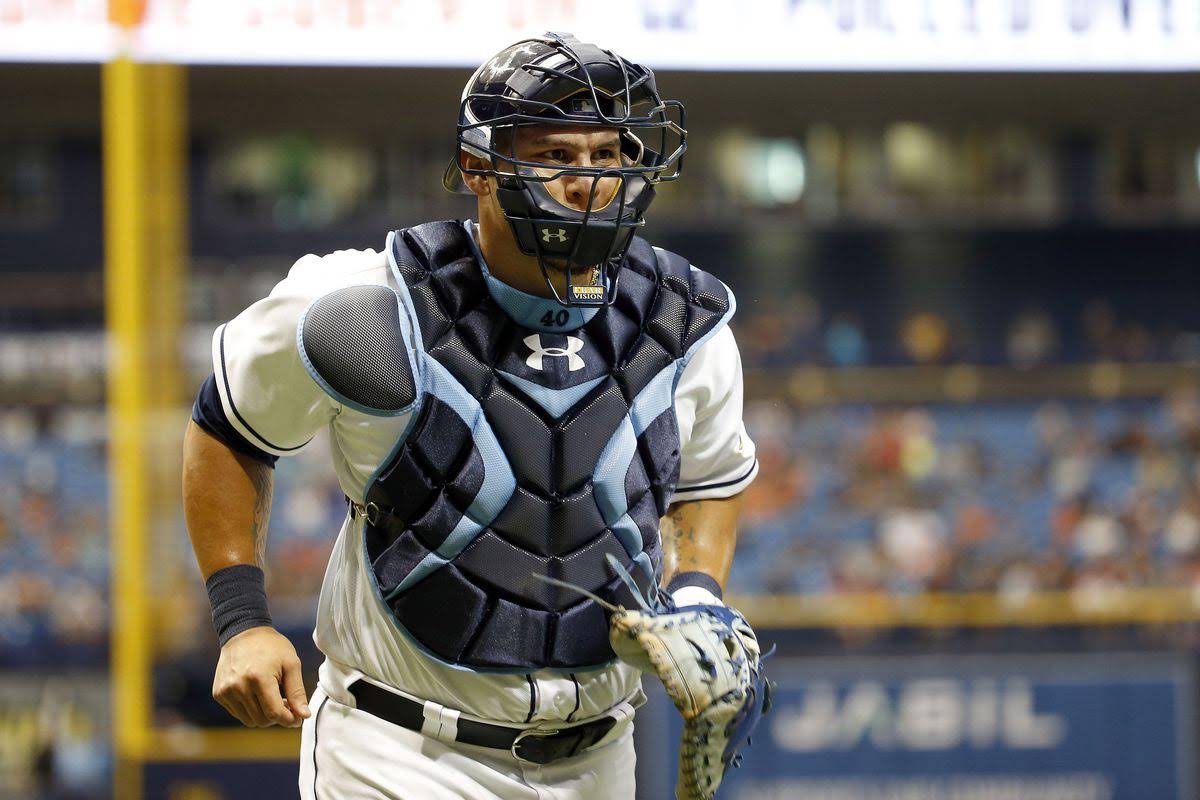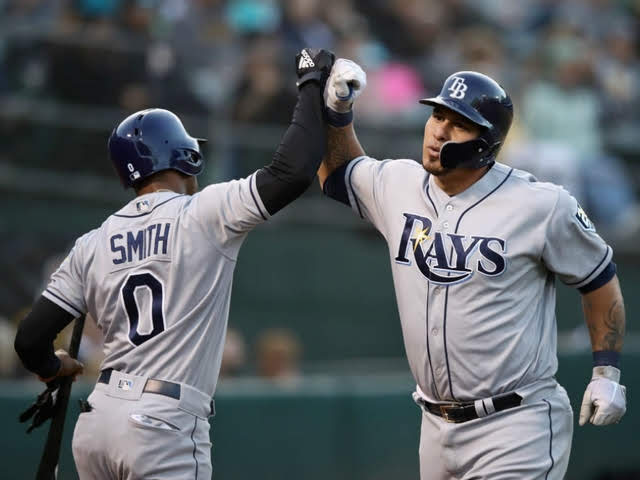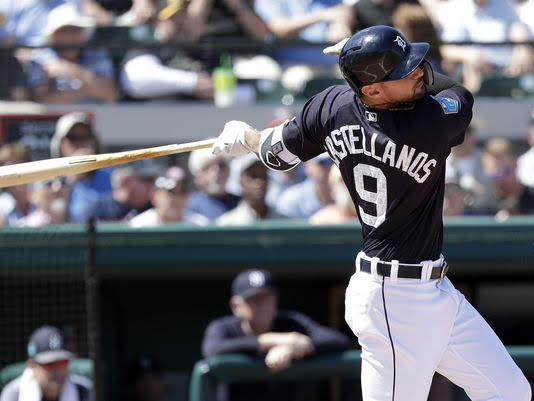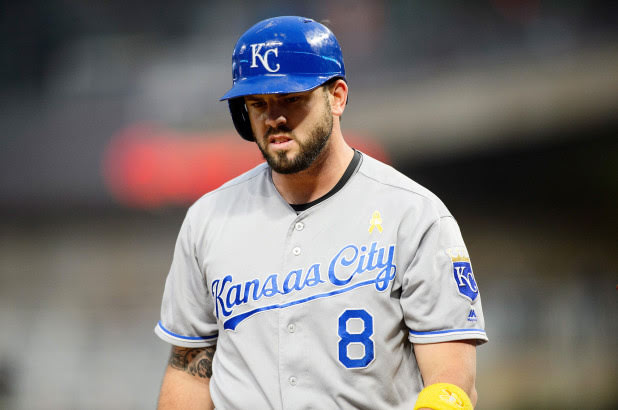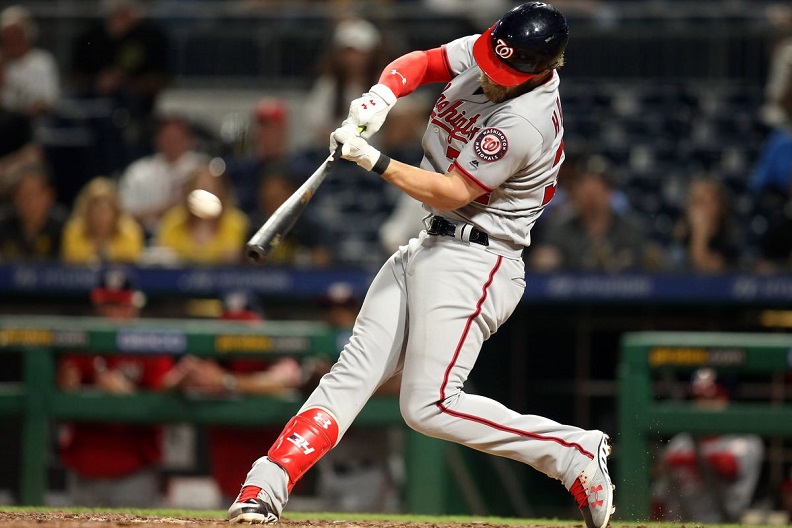Right field is a very top heavy position. Not knowing yet how the Yankees will utilize their two sluggers, they both get included in right field as that’s where they have played previously. There is also a good chance they both play right field this season, rotating between there and DH. After a group of four superstars, the position has a steep drop-off. Who helps round out the top 10 for the best right fielders to have for the long haul?
1. Bryce Harper
Harper may not have been a consistent superstar to this point, but he is still only 25 years old. Harper has also put up superstar numbers for two of the last three seasons now while healthy. With his upside, and still being only 25, it is hard to argue against him in the top spot.
One of the most hyped phenoms of all-time, Harper broke in to the Major Leagues at the age of 19. Although it took a few years for him to achieve star numbers, he was good immediately. He hit 20 homers in each of his first two seasons and won the Rookie of the Year Award in 2012. Harper truly broke out in 2015 at just 22 years old. That season he won the MVP Award after leading the league in home runs, on-base percentage and slugging percentage. He batted .330 with a .460/.649/1.109 slash line, showing the world his immense upside. Although he “slumped” to an .814 OPS the next year, Harper bounced back last season before getting injured. He again had an OPS over 1.000 while batting .319 with 29 home runs over 420 at-bats.
The biggest concern with Harper’s productivity moving forward may be health. Harper has now missed a relatively large amount of time in half of his six Major League seasons. When healthy, Harper should threaten 40 home runs with a near 1.000 OPS for years to come.
2. Giancarlo Stanton
Stanton is another superstar right fielder who has struggled with injuries. Stanton has missed significant time in four of his Major League seasons. Despite all the missed time, Stanton’s 267 career home runs place him in the top 10 for most home runs through the age of 27. That number is more than Hank Aaron, Barry Bonds, Willie Mays and Babe Ruth. Imagine how many Stanton would have if not for the injuries. Heck, the last couple years he got hurt were fluke injuries. For his career, he has averaged 44 home runs per 162 games played.
In 2015, at the time of his beaning, Stanton was on pace for a 50 home run season. Last year he achieved it for real, bashing a league high 59 home runs. Now, leaving Miami, Stanton gets to play in a hitter’s park instead of a pitcher’s park. If he stays healthy, Stanton could see a couple more 50 home run seasons in his future. Health is the key for the man who hits the ball harder than anyone I have seen.
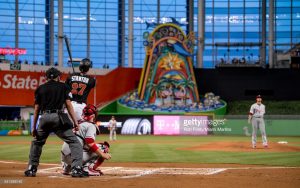
Stanton won’t be taking aim at this ugly sculpture anymore. (Getty Images)
3. Aaron Judge
Personally, I think we just saw Aaron Judge’s career year, but after what he accomplished as a rookie, it’s hard to put him lower than three. Judge never hit all that well in the minors, posting a high of 20 home runs in 2015. He also only batted better than .280 once, back in his first season. Yet, his first year in the bigs and Judge batted .284 with a league leading 52 home runs. Strange how things work out sometimes. Judge also led the league in walks, 127, and strike outs, 208. Judge then struck out 27 times in 13 postseason games. To keep his average up, he will certainly have to cut back on his strike outs.
Diving into his numbers, 25.9% of Aaron Judge’s fly balls traveled for home runs. That is an insanely high rate, as the league average is 9.6%. I have to think that number will come down, and probably below 20%. As for his strike out rate, which was higher than 30%, that definitely will need to improve for a repeat performance. A .357 BABIP, which places him in the top 10, helped him to his .284 average despite all the strike outs.
Now, all this isn’t saying Aaron Judge is going to be a bad player. I am merely pointing out his underlying numbers which tend to show he won’t be as good moving forward. If Judge drops to a .250 batting average, with the way he walks he will still have better than a .350 on-base percentage.
4. Mookie Betts
I would not be surprised if Betts provided more value moving forward than some guys ahead of him on my list. Coming off a “down season” it is hard to justify putting him higher than 4th. He is easily the best fielder of this bunch though and he was an MVP candidate two seasons ago. Betts also has the most speed of anyone to this point, giving him arguably the most well-rounded game of the group.
Betts strikes out far less than the average player, striking out in only 11.8% of his career plate appearances. That number has been right round 11% in back to back seasons now. Assuming his BABIP normalizes, he should bounce back to closer to the player he was two years ago. That season, Betts had 214 base hits on his way to a .318 batting average. He also hit 31 home runs, 42 doubles and stole 26 bases as he finished second to Mike Trout for the American League MVP Award. He didn’t benefit from a high BABIP (.320). But last season, Betts’ BABIP dropped all the way down to .268. He still hit 24 home runs and 46 doubles though, while once again stealing 26 bases. With a return to normalcy, Betts should be around the .300 mark again this season.
As for his defense, Betts has won two straight Gold Glove Awards while posting a 5.4 dWAR. He has saved more than 30 defensive runs above average in both seasons, totaling 63 between the seasons. His 31 last year were 13 more than any other right fielder had. At 25 years old, Betts should be an all-around star for years to come.
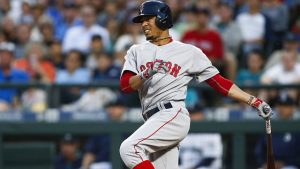
Boston Red Sox right fielder Mookie Betts hits a double against the Seattle Mariners during the sixth inning at Safeco Field. Mandatory Credit: Joe Nicholson-USA TODAY Sports
5. Domingo Santana
This is where the position drops off, though Santana is still a good player. Given a chance to start for the first time last season, Santana hit 30 home runs. Not only that, Santana exhibited the ability to draw a walk, walking 73 times. This gave Santana an excellent .371/.505/.875 slash line. The on-base percentage placed him 4th among all right fielders and the slugging percentage was 6th. Not bad for a first full season.
Santana always exhibited ability, twice hitting over 20 home runs in the minors and another time posting a .999 OPS. He was a big piece of the Astros trade to acquire Mike Fiers and Carlos Gomez in 2015 for the stretch run. Playing half a season in the bigs in 2016, Santana hit 11 home runs and posted a .792 OPS. Yes, he was much better this past season, but it’s not like the season came out of nowhere. Also, young guys are supposed to improve, right? The ability is real, if anything drops some it will be his batting average after he benefited from a .363 BABIP this past year.
6. Nicholas Castellanos
After being a third baseman his whole career, Castellanos will call right field his home this season. He played 20 games there late last year to see if he could handle it. How he performs there is yet to be determined. As for the bat, that will play in right. Castellanos made Baseball America’s top 100 list four times, twice placing in the top 25. He then spent his first full season in the majors at the age of 22. It’s not a surprise it took him a few years to start producing, but he has now had two straight excellent seasons at the dish.
Castellanos took a big step forward two years ago, batting .285 with 18 home runs and an .827 OPS. Despite a slow start last season, Castellanos hit a career high 26 home runs and led the league with 10 triples. The numbers look sustainable, as his extra base hit percentage and home run rate have held steady the last two seasons. Castellanos has also improved his strike out rate in back to back years. Turning 26 in a couple of days, Castellanos should be entering his prime.
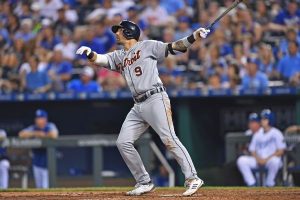
7. Andrew McCutchen
McCutchen has the superstar name, and certainly has been one, but he is on the wrong side of 30 now. His game has shown obvious signs of decline as he no longer has the speed to steal many bases or to play center field. McCutchen looks like he will play primarily right field for the first time in his career this season as he makes the move to San Francisco.
McCutchen may not be an MVP candidate anymore, but he still has a good bat. At 31, he isn’t so ancient that we should be expecting him to continue to rapidly decline. He still should have a few good seasons left in him. He isn’t the .300 hitter he was from 2012-2014, falling short of that mark in each of the last three seasons. However, he did bat .279 with 28 home runs last season. He probably will provide more value on defense as well playing in right field. He posted negative defensive value playing center in each of the last four seasons. However, McCutchen posted positive value in a 13 game stint in right field last year.
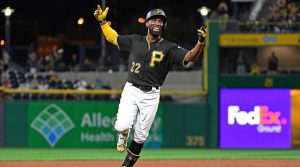
McCutchen will call San Francisco his home after spending his first 9 seasons in Pittsburgh.
8. Jay Bruce
Bruce will join McCutchen as a 31 year old shortly after the season begins. Although the age does him no favors in my long-term articles, it’s by no means a death knell. There is no reason why he can’t continue hitting into his mid-thirties at least. He ultimately may find himself moved to first base, a position he has played a little of before.
Bruce is a fairly one-dimensional slugger. Although he isn’t allergic to walks, he doesn’t walk too often. He doesn’t hit for a high average, he doesn’t steal bases, he mostly just slugs home runs. At least he seems to be a pretty good player again. From 2010-2013, Bruce batted .262 and averaged 30 home runs per year. He then had two very poor seasons, batting .222 without posting any real value. However, he is back to being the player he was before 2014 it seems. Bruce has hit .252 the last two seasons while hitting 69 home runs. He is coming off a career high 36 home runs last season. He looks like he should be a .250 30 home run hitter for a couple more seasons.
9. Yasiel Puig
Puig is a polarizing player, both on and off the field. He looked like a future star his first two seasons, batting .305 with an .888 OPS. His arm in right field was a weapon as well as his bat. Then his play fell off the next two seasons, batting just .260 with a .748 OPS. He hit only 22 home runs combined those two years and was sent to the minors in 2016. His attitude was considered to be a problem both on and off the field.
Still just 26 last season, Puig’s play rebounded. He still hit just .263, but he clubbed a career high 28 home runs. Puig posted an .833 OPS, his best in three seasons. His play in the outfield was arguably the best of his career, putting up 18 defensive runs saved above average. Runners don’t test his arm like they used to, as Puig had just 4 assists. But he’s still holding runners, and he only made one error.
So, which Puig will we see moving forward? Can he continue to be a force on the field or will his play regress again? Puig also carries the character concerns, meaning he could affect team chemistry even when going well. Still just 27 years old, Puig has plenty of time to turn his career around.
10. Nomar Mazara
Mazara was just 20 years old when he made the majors, and he has held his own. The number 21 prospect according to Baseball America in 2016, Mazara batted .266 and hit 20 home runs. Last season, he had his peaks and valleys, showing all the streakiness one might expect from a 22 year old. When all was said and done he had hit 22 home runs, doubled 30 times and driven in 101 runners. His average dropped a bit, while his other rate stats saw incremental gains.
I believe there is more in him waiting to show the world. He was a big prospect brought to the majors at such a young age. Still just 22 at the start of the year, Mazara has plenty of development left. He’s got plenty of power in his 6’4″ 215 pound frame, and I expect his skills to become more toned and consistent. I expect Mazara to post career highs across the board this season, except maybe runs batted in.
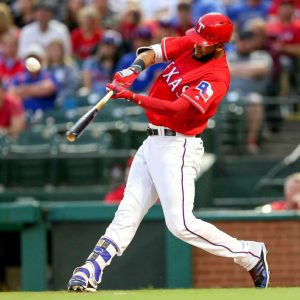
Honorable Mentions:
Steven Souza Jr., Avisail Garcia, Mitch Haniger, Gerardo Parra, David Peralta, Stephen Piscotty, Gregory Polanco, Josh Reddick, Scott Schebler, Randal Grichuk
Feature picture from Federalball.com
